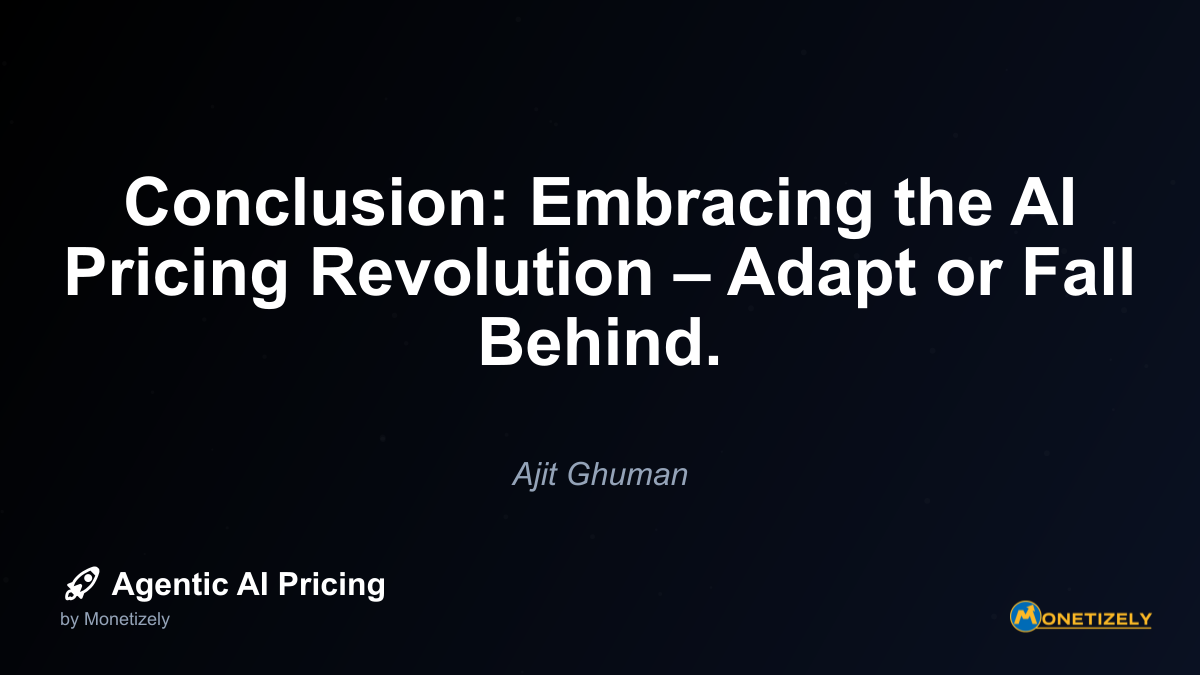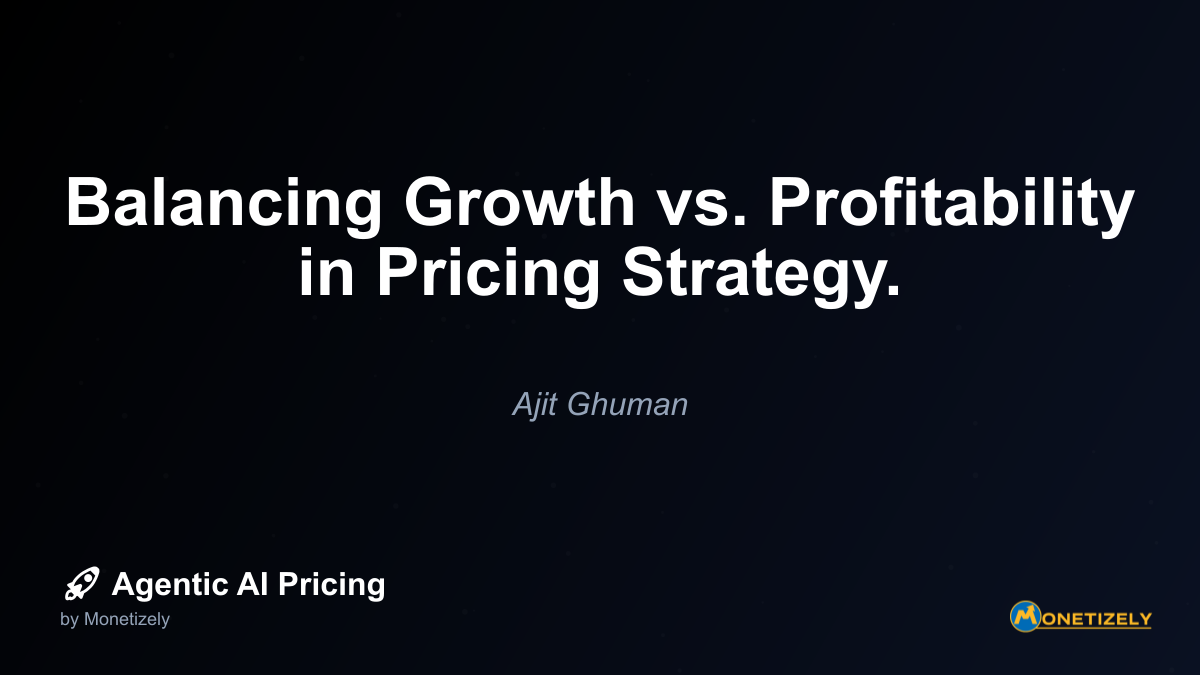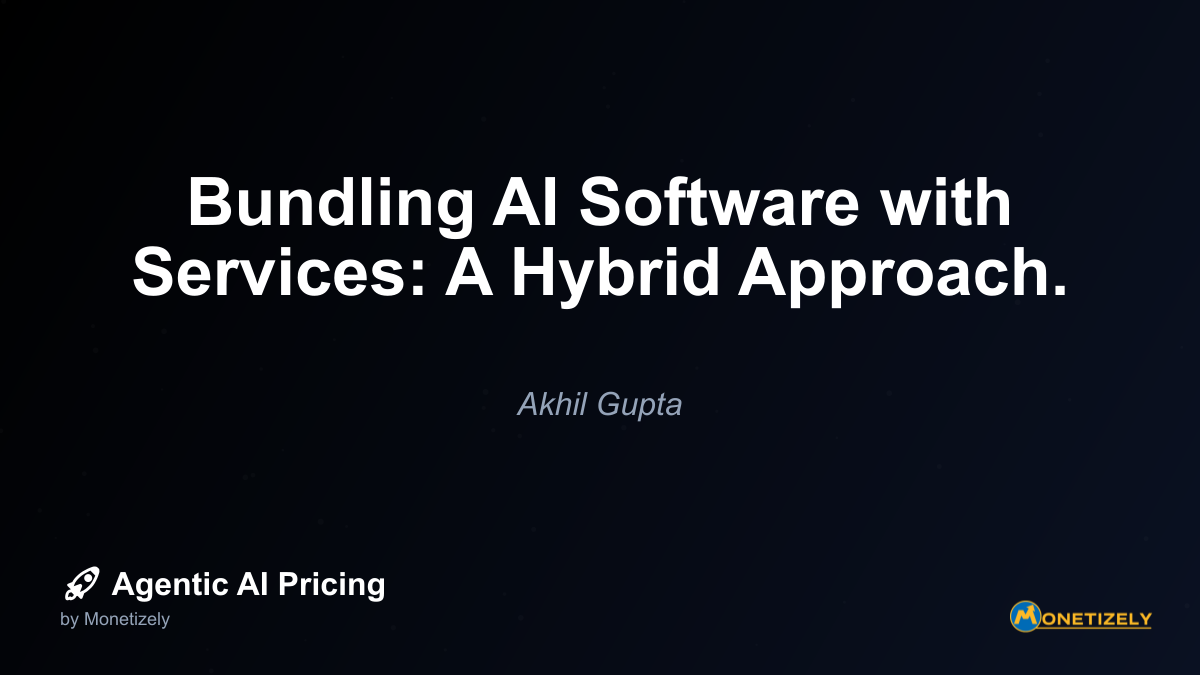· Ajit Ghuman · Strategy & Planning · 7 min read
Conclusion: Embracing the AI Pricing Revolution – Adapt or Fall Behind.
AI and SaaS Pricing Masterclass
Learn the art of strategic pricing directly from industry experts. Our comprehensive course provides frameworks and methodologies for optimizing your pricing strategy in the evolving AI landscape. Earn a professional certification that can be imported directly to your LinkedIn profile.

The AI pricing revolution is no longer a futuristic concept—it’s today’s competitive reality. Companies embracing innovative pricing models for their AI solutions are already reaping significant rewards, while those hesitating face increasingly difficult catch-up journeys. As we’ve explored throughout this series, the landscape of AI pricing is fundamentally transforming how technology is monetized, delivered, and evaluated.
The Transformation of AI Pricing is Accelerating
Recent market research reveals a dramatic shift in AI pricing approaches. By 2025, AI-powered pricing is expected to be implemented by 75% of organizations, up from just 10% in 2020. This represents not merely an incremental change but a complete reimagining of how technology delivers and captures value.
The most forward-thinking companies are moving beyond traditional subscription and licensing models toward more sophisticated approaches:
- Value-based and outcome-based pricing that aligns costs directly with measurable business results
- Dynamic pricing that adjusts in real-time to market conditions, usage patterns, and customer segments
- Consumption-based models that provide greater flexibility and transparency
- Hybrid approaches that combine multiple pricing strategies to optimize both customer experience and revenue
As one pricing executive noted at the Sapphire 2025 conference: “AI is no longer an add-on; it’s the centerpiece for pricing transformation, offering the fastest path to value realization.”
Early Adopters Are Gaining Decisive Advantages
Companies that have successfully implemented innovative AI pricing models are creating significant competitive moats. The data shows these early adopters are experiencing:
- Shorter sales cycles (reduced by up to 15-20%)
- Higher customer satisfaction and adoption rates
- Reduced operational costs (some reporting 12% reductions in sales and marketing expenses)
- Improved revenue predictability and growth
One enterprise tech company using AI-powered pricing and sales agents saw a 35% increase in demo requests, a 27% jump in proposal submissions, and reduced their sales cycle from 120 to 90 days—translating to $230,000 in quarterly cost savings while simultaneously boosting revenue.
These aren’t isolated examples. The pattern is clear: companies that align their pricing models with the unique value proposition of AI are outperforming those stuck in traditional paradigms.
The Cost of Inaction is Growing
While the benefits of innovative AI pricing are compelling, the risks of inaction are perhaps even more significant. Industry experts warn that delaying AI adoption in pricing creates widening efficiency gaps that become increasingly difficult to overcome.
As strategic analysis on AI adoption risk notes: “Every day spent waiting adds to the cost, leaving organizations vulnerable to competitors who are already leveraging the power of AI.”
The cautionary tale of Zillow Offers demonstrates how even well-resourced companies can falter when implementing AI pricing without sufficient testing and oversight. Their algorithm’s mispricing of homes in volatile markets led to over $300 million in losses and a 25% workforce reduction before shuttering the program entirely.
Key Barriers to Successful Implementation
Despite the clear imperative to evolve pricing strategies, companies face several significant challenges:
Regulatory and Ethical Considerations
AI pricing models must navigate complex ethical and legal issues, including:
- Risks of algorithmic bias and price discrimination
- Transparency requirements that vary by region
- Data privacy concerns and compliance frameworks
- The need for explainable AI that regulators and customers can understand
Customer Acceptance Challenges
Innovative pricing approaches can face resistance from customers accustomed to traditional models:
- Negative reactions to perceived unpredictable or unfair price fluctuations
- Tensions between usage-based models and customers’ desire for cost predictability
- The need for transparent communication about how dynamic pricing benefits customers
Organizational Transformation Requirements
Implementing AI pricing demands substantial internal changes:
- Building robust data infrastructure for collecting and processing diverse datasets
- Integrating AI pricing systems with existing billing, CRM, and marketing technologies
- Developing specialized cross-functional teams combining pricing strategy and AI expertise
- Overcoming workforce resistance through training and education
A Strategic Framework for Adaptation
For companies ready to embrace the AI pricing revolution, a structured approach can maximize chances of success:
1. Identify Your AI Product Type and Value Proposition
Begin by clearly defining what your AI solution actually delivers:
- Is it primarily processing data, providing insights, automating tasks, or offering predictions?
- What specific, measurable benefits does it provide to customers?
- How does it differ from both traditional solutions and competitive AI offerings?
2. Select the Optimal Pricing Model
Choose from several proven approaches based on your specific situation:
Usage-Based Pricing:
- Charges based on volume of data processed, API calls, or compute resources
- Provides flexibility for customers with variable usage patterns
- Examples include OpenAI’s token-based model
Value-Based Pricing:
- Ties pricing to quantifiable customer benefits
- Works best for solutions with easily measurable economic impact
- Example: Charging $30,000 for a product that saves $100,000 in labor costs
Outcome-Based Pricing:
- Charges based on achieved results (cost savings, revenue increases, etc.)
- Ideal for high-confidence AI systems with predictable outcomes
- Example: AI-driven customer support solutions charging per resolved ticket
Tiered Subscription Model:
- Offers different levels of functionality or support
- Fosters customer loyalty and allows for scalability
- Common approach with Basic, Professional, and Enterprise tiers
Hybrid Models:
- Combines multiple pricing approaches to balance predictability with flexibility
- Example: Microsoft’s approach blending per-user charges with usage-based components
3. Implement a Continuous Learning Approach
The most successful AI pricing implementations treat pricing as an ongoing experiment:
- Start with small-scale pilots before full deployment
- Collect robust data on customer response and financial performance
- Regularly review and adjust based on market feedback
- Build in flexibility to adapt as AI capabilities evolve
The Path Forward: Experimentation as Strategy
The companies that will thrive in the AI era are those that view pricing not as a static decision but as a strategic capability requiring continuous innovation. As leading SaaS operators emphasized in a recent industry report: “Pricing is now product strategy.”
This mindset shift demands that organizations:
Build pricing experimentation into their DNA
- Create dedicated teams focused on pricing innovation
- Develop metrics to evaluate pricing experiments
- Foster a culture that celebrates pricing creativity
Develop robust data infrastructure
- Invest in systems that capture customer usage patterns
- Build analytics capabilities to derive pricing insights
- Create feedback loops between pricing, product, and sales
Align organizational incentives
- Ensure sales teams are incentivized to sell innovative pricing models
- Train customer success to communicate value effectively
- Educate leadership on the strategic importance of pricing
Communicate transparent value propositions
- Clearly articulate how pricing aligns with customer value
- Develop narratives that explain the benefits of new models
- Create tools to help customers understand their costs
The Future Belongs to the Adaptable
The AI pricing revolution is not merely a technical challenge—it’s a fundamental strategic imperative that will separate market leaders from laggards in the coming years.
Boston Consulting Group highlights that the rise of AI agents is driving a shift toward outcome-based pricing models where customers pay based on measurable results rather than seats or licenses. This transformation demands companies rethink not just pricing but their entire approach to value creation and capture.
The companies that will thrive are those that embrace this change proactively, experimenting with new models that align more closely with the unique value proposition of AI. Those that cling to traditional pricing approaches risk being left behind as customers increasingly gravitate toward solutions that offer more flexibility, transparency, and alignment with their business outcomes.
As we stand at this inflection point, the message is clear: the AI pricing revolution waits for no one. The time to adapt is now.
Your Next Steps
- Assess your current pricing model against the innovative approaches outlined in this series
- Identify one area where you could experiment with a more AI-aligned pricing approach
- Start small with controlled experiments before scaling successful models
- Build your pricing intelligence by investing in data infrastructure and analytics
- Create a cross-functional team dedicated to pricing innovation
Remember that pricing transformation is a journey, not a destination. The most successful companies will be those that continuously evolve their approach as technology, markets, and customer expectations change.
The AI pricing revolution is here. The only question is whether you’ll be leading it or struggling to catch up.
Co-Founder & CEO
Ajit is the author of Price To Scale, a top book on SaaS Pricing and is the Founder of Monetizely. Ajit has led and worked in pricing and product marketing at firms like Twilio, Narvar and Medallia. His work has been featured in Forbes and VentureBeat. Ajit regularly consults with software companies from Seed stage to post-IPO on pricing strategy. Ajit is also a highly-rated co-instructor for 'The Art of SaaS Pricing and Monetization' on Maven.
Pricing Strategy Audit
Let our experts analyze your current pricing strategy and identify opportunities for improvement. Our data-driven assessment will help you unlock untapped revenue potential and optimize your AI pricing approach.




